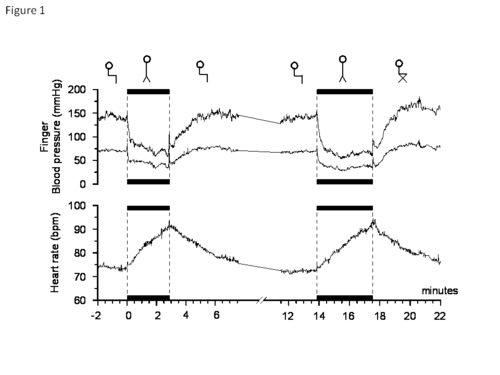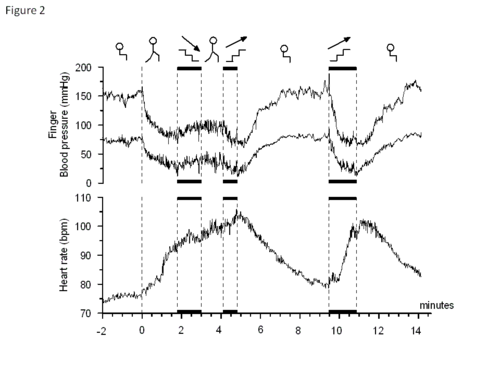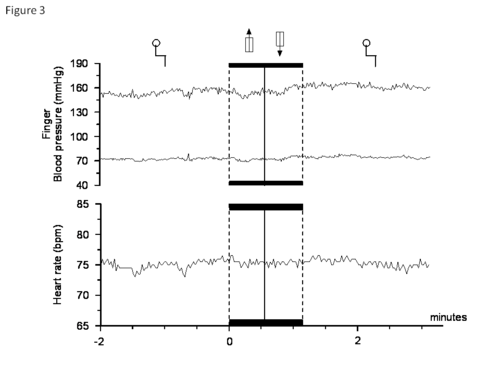Effects of some common daily activities on orthostatic tolerance in a patient with pure autonomic failure: Difference between revisions
Jelledejong (talk | contribs) (Created page with "''Stefano Omboni MD, Han van Lieshout, Wouter Wieling '' ''Clinical Research Unit, Italian Institute of Telemedicine'' ==Introduction== Ordinary daily activities greatly infl...") |
Jelledejong (talk | contribs) No edit summary |
||
| Line 6: | Line 6: | ||
==Case Description== | ==Case Description== | ||
[[File:PAF_daily_fig1.jpg | thumb | 500px | right | Figure 1. Continuous non-invasive finger systolic and diastolic blood pressure and heart rate during standing followed by sitting on a regular chair (left hand side) or on fishing chair (right hand side). Zero refers to the beginning of the first standing period. Symbols on top of the Figure report the specific patient’s activity.]] | |||
[[File:PAF_daily_fig2.jpg | thumb | 500px | right | Figure 2. Continuous non-invasive finger systolic and diastolic blood pressure and heart rate when going down or up stairs. Zero refers to the beginning of walking. Symbols on top of the Figure report the specific patient’s activity.]] | |||
[[File:PAF_daily_fig3.jpg | thumb | 500px | right | Figure 3. Continuous non-invasive finger systolic and diastolic blood pressure and heart rate when taking an elevator. Zero refers to the beginning of the test. Symbols on top of the Figure report the specific patient’s activity. Arrows refer to the direction of the elevator (up or down).]] | |||
This case history refers to a 66 year old woman with a 3 year history of symptomatic orthostatic hypotension due to pure autonomic failure. The patient was studied after 7 days of treatment with fludrocortisones 0.1 mg once-daily, combined with 12° head-up tilt sleep, and a 150 mmol sodium diet. Blood pressure was measured non-invasively beat-to-beat at the finger level by the Portapres model 1 device. We previously reported on the effects in this patient of main daily activities, including standing and walking, on blood pressure and symptoms <cite>1</cite>. In the former publication we demonstrated that tolerance to standing and exercise increased during the day and, as a consequence of a higher upright mean blood pressure, was improved after treatment. | This case history refers to a 66 year old woman with a 3 year history of symptomatic orthostatic hypotension due to pure autonomic failure. The patient was studied after 7 days of treatment with fludrocortisones 0.1 mg once-daily, combined with 12° head-up tilt sleep, and a 150 mmol sodium diet. Blood pressure was measured non-invasively beat-to-beat at the finger level by the Portapres model 1 device. We previously reported on the effects in this patient of main daily activities, including standing and walking, on blood pressure and symptoms <cite>1</cite>. In the former publication we demonstrated that tolerance to standing and exercise increased during the day and, as a consequence of a higher upright mean blood pressure, was improved after treatment. | ||
In the next paragraphs results of the effects on blood pressure of other typical daily activities in this patient, while under specific treatment, will be shown. | In the next paragraphs results of the effects on blood pressure of other typical daily activities in this patient, while under specific treatment, will be shown. | ||
===Derby-chair test=== | ===Derby-chair test=== | ||
The patient occasionally discovered that carrying around a derby or fishing chair and using it when heavy orthostatic symptoms occurred (dizziness or near-fainting) was very helpful for her. As shown in the Figure 1 (left hand side) when the patient sat on a regular chair systolic blood pressure, and to a less extent diastolic blood pressure, were much lower than sitting on a derby chair (right hand side). Using the derby chair reduced the severity of symptoms and allowed a more rapid recover from dizziness. | The patient occasionally discovered that carrying around a derby or fishing chair and using it when heavy orthostatic symptoms occurred (dizziness or near-fainting) was very helpful for her. As shown in the Figure 1 (left hand side) when the patient sat on a regular chair systolic blood pressure, and to a less extent diastolic blood pressure, were much lower than sitting on a derby chair (right hand side). Using the derby chair reduced the severity of symptoms and allowed a more rapid recover from dizziness. | ||
===Effect of stair climbing=== | ===Effect of stair climbing=== | ||
Also stair climbing was very disabling for the patient. To test the hemodynamic effect of this activity we let the patient walk and then she went down the stairs, she walk and she went up the stairs. As shown in Figure 2, climbing the stairs was associated with a larger blood pressure decrease than descending the stairs. Symptoms also occurred in the former phase. Interestingly when more floors where done (right hand side of Figure 2) the activity was felt as much heavier by the patient and much larger was the blood pressure fall. | Also stair climbing was very disabling for the patient. To test the hemodynamic effect of this activity we let the patient walk and then she went down the stairs, she walk and she went up the stairs. As shown in Figure 2, climbing the stairs was associated with a larger blood pressure decrease than descending the stairs. Symptoms also occurred in the former phase. Interestingly when more floors where done (right hand side of Figure 2) the activity was felt as much heavier by the patient and much larger was the blood pressure fall. | ||
===Elevator test=== | ===Elevator test=== | ||
A very common activity, like taking an elevator, may also heavily affect patient’s quality of life. We asked the patient to sit down for 2 minutes before the test. Then the patient stood up, and we continued to record her blood pressure for 30 seconds when the elevator was going up few floors and then for the subsequent 30 seconds when the elevator was going down. In our patient, taking the elevator in standing position was associated with a sudden and net decrease in blood pressure followed by stabilization (Figure 3). This activity caused symptoms, even of a mild severity. When the elevator went down, blood pressure gradually and slightly increased. These changes were minor (1-2 mmHg, mean blood pressure), but it should be noted that before treatment the same activity caused a decrease in mean blood pressure of 30-40 mmHg (and symptoms), with no differences when the elevator was sent up or down. | A very common activity, like taking an elevator, may also heavily affect patient’s quality of life. We asked the patient to sit down for 2 minutes before the test. Then the patient stood up, and we continued to record her blood pressure for 30 seconds when the elevator was going up few floors and then for the subsequent 30 seconds when the elevator was going down. In our patient, taking the elevator in standing position was associated with a sudden and net decrease in blood pressure followed by stabilization (Figure 3). This activity caused symptoms, even of a mild severity. When the elevator went down, blood pressure gradually and slightly increased. These changes were minor (1-2 mmHg, mean blood pressure), but it should be noted that before treatment the same activity caused a decrease in mean blood pressure of 30-40 mmHg (and symptoms), with no differences when the elevator was sent up or down. | ||
Latest revision as of 11:39, 22 November 2017
Stefano Omboni MD, Han van Lieshout, Wouter Wieling Clinical Research Unit, Italian Institute of Telemedicine
Introduction
Ordinary daily activities greatly influence blood pressure in patients with neurogenic orthostatic hypotension. In particular, orthostasis and exercise are the main conditions causing hypotension in these patients, limiting their daily activities and influencing their quality of life. Unfortunately, the occurrence of symptoms in relation to hemodynamic changes is largely unpredictable and subjective in these patients. It is also difficult to be documented in details. Use of continuous, non-invasive, 24 hour finger blood pressure monitoring, may be helpful to evaluate blood pressure trends during the course of the day in patients with orthostatic hypotension.
Case Description

This case history refers to a 66 year old woman with a 3 year history of symptomatic orthostatic hypotension due to pure autonomic failure. The patient was studied after 7 days of treatment with fludrocortisones 0.1 mg once-daily, combined with 12° head-up tilt sleep, and a 150 mmol sodium diet. Blood pressure was measured non-invasively beat-to-beat at the finger level by the Portapres model 1 device. We previously reported on the effects in this patient of main daily activities, including standing and walking, on blood pressure and symptoms [1]. In the former publication we demonstrated that tolerance to standing and exercise increased during the day and, as a consequence of a higher upright mean blood pressure, was improved after treatment. In the next paragraphs results of the effects on blood pressure of other typical daily activities in this patient, while under specific treatment, will be shown.
Derby-chair test
The patient occasionally discovered that carrying around a derby or fishing chair and using it when heavy orthostatic symptoms occurred (dizziness or near-fainting) was very helpful for her. As shown in the Figure 1 (left hand side) when the patient sat on a regular chair systolic blood pressure, and to a less extent diastolic blood pressure, were much lower than sitting on a derby chair (right hand side). Using the derby chair reduced the severity of symptoms and allowed a more rapid recover from dizziness.
Effect of stair climbing
Also stair climbing was very disabling for the patient. To test the hemodynamic effect of this activity we let the patient walk and then she went down the stairs, she walk and she went up the stairs. As shown in Figure 2, climbing the stairs was associated with a larger blood pressure decrease than descending the stairs. Symptoms also occurred in the former phase. Interestingly when more floors where done (right hand side of Figure 2) the activity was felt as much heavier by the patient and much larger was the blood pressure fall.
Elevator test
A very common activity, like taking an elevator, may also heavily affect patient’s quality of life. We asked the patient to sit down for 2 minutes before the test. Then the patient stood up, and we continued to record her blood pressure for 30 seconds when the elevator was going up few floors and then for the subsequent 30 seconds when the elevator was going down. In our patient, taking the elevator in standing position was associated with a sudden and net decrease in blood pressure followed by stabilization (Figure 3). This activity caused symptoms, even of a mild severity. When the elevator went down, blood pressure gradually and slightly increased. These changes were minor (1-2 mmHg, mean blood pressure), but it should be noted that before treatment the same activity caused a decrease in mean blood pressure of 30-40 mmHg (and symptoms), with no differences when the elevator was sent up or down.
Discussion
Our case report interestingly shows how continuous non-invasive blood pressure monitoring during the 24 hours may allow assessing the impact of common everyday activities on blood pressure and symptoms in a typical patient with orthostatic hypotension due to pure autonomic failure. Interestingly, not all activities were associated with a similar effect. For instance climbing the stairs, particularly if more floors were done, was definitely more invalidating that descending the stairs. Similarly, going up with the elevator was less tolerated than going down. Patients with orthostatic hypotension may find expedients to increase blood pressure and improve symptoms. In our case, the patient discovered by herself the relieving effect of sitting on a derby chair after a relatively long period of standing. We were able to prove that such a maneuver had a positive hemodynamic effect, explaining the benefits reported by the patient.

